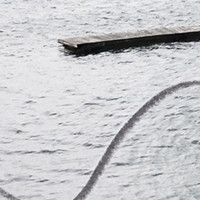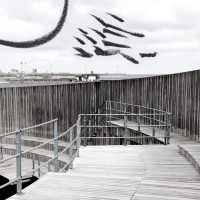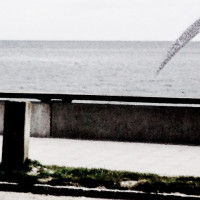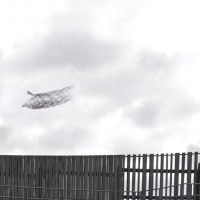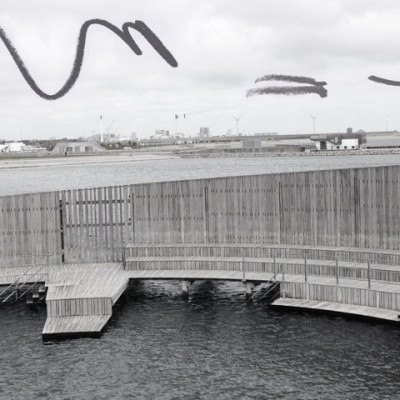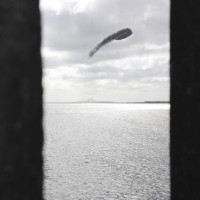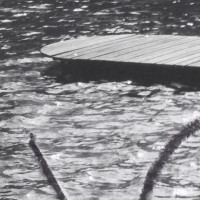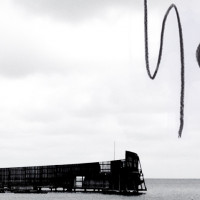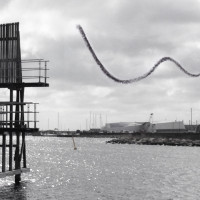Explorations and analysis of soundscapes have, since Canadian R. Murray Schafer's work during the early 1970's, developed into various established research - and artistic disciplines. The interest in sonic environments is today present within a broad range of contemporary art projects and in architectural design. Aesthetics, psychoacoustics, perception, and cognition are all present in this expanding field embracing such categories as soundscape composition, sound art, sonic art, sound design, sound studies and auditory culture. Of greatest significance to the overall field is the investigation of sound, site and the social, and how the spatial, the visual, and the bodily interact in sonic environments, how they are constructed and how they are entangled in other practices.
With the Seismograf special issue Fluid Sounds, we bring this knowledge into the dissemination of audio research itself by introducing a new format: The Audio Paper. The purpose of the audio paper is to extend the written academic text: to present discussions and explorations of a certain argument or problem in sound. The audio paper is an extension of expressive means: Not only words and syntax are means of expression – so are tempo, time, voice, sound and music. Our goal is to bring analytical and performative awareness to academic means of expression, and the audio paper provides us with a new and experimental platform to do so. Our thoughts about and definition of the audio paper is explained in the first text of the issue: Audio Papers – a manifesto.
From site specific audio performances to academic audio paper
The first presentation of the audio papers took place in June 2015 during the conference Fluid Sounds, a cluster during the Performance Studies International annual conference, Fluid States – performances of unknowing. (Read more about the conference)
The aim of the conference was partly to investigate the selected sites of the immediate area (Amager Strandpark, Urbanplanen and Musiktorvet), and partly to challenge the conventional conference format with performances (in the widest sense) and by drawing from the development in recent information technologies. The aim was to work with new mediated formats taking the bodily, situated and affective modes of research into play.
By merging anthropologies of sound with site-specific performances, the conference explored new ways of investigating urban spaces and landscapes. Underlining listening, sensing and experiencing as part of research processes the Fluid Sounds conference wished to venture into artistic research practices. Or, as addressed in Holger Schulze’s opening keynote lecture, taking place at Kastrup Søbad (a.k.a. Sneglen), "Research in a specific sensory or non-sensory field requires at first a basic orientation, a sensible and maybe unconventional but always highly individual account of what is actually there: What is here, what have we now?" Schulze’s lecture was followed by two site-specific performances in Urbanplanen: Brandon LaBelle’s On the productions of a poor acoustics and Jeremy Woodruff’s Green Interactive Biofeedback Environments (GIBE). (Further analyses in Groth & Samson (2016) Sound Art Situations, forthcoming).This day of the conference ended at Teaterøen, with the performance music4gigants by Heaven.
Fluid Sounds was not only an exploration of how to gain knowledge through site-specific lectures and performance; it was also a conference with the purpose to transform academic knowledge into various aesthetic and performative formats such as site-specific sound performances, audio walks or sound installations. The audio papers were developed through workshops during the conference. As such, they serve as an academic response to questions of situations, performances and media technologies.
In Nicole De Brabandere and Graham Fletts Hearing on the Verge, a sonic landscape is engaged through recording and listening in movement. Anne Robinson explores songs as temporal and affective phenomena. Ben Byrne revisits the Swiss composer Manfred Werder’s work 2005 (1) and relates to the work of John Cage. Jacob Kreutzfeldt and Sandra Lori Pedersen argue that the radio studio is acoustically designed to be inaudible, but is yet ever-present as a prerequisite for voices and situations. Pedro Oliviera contributes with a speculative audio paper about the past of 2055, assessing site-specific found objects coming from a near-future. Rasmus Holmboe and Jan Stricker go into dialogue with the artist Andreas Frührer and his audio walk The Map is Not the Territory D’Or. Macon Holt and Kartine Pram explore new forms of labour expanding notions of place and work itself. And finally, Tine Blom and Alexandra Baixinho combine soundscapes from Norwegian mountains with a Danish urban waterfront.
All audio papers have been peer reviewed. During this process we asked the reviewers to classify the papers as either an “academic audio paper” or an “experimental audio paper”. Papers qualifying for the first category had to investigate and answer a research question, while the others could be slightly freer in format.
The conference was supported by The Danish Council for Independent Research, Humanities (FKK) and Designing Human Technologies, Roskilde University.
This Fokus is developed and edited by Sanne Krogh Groth and Kristine Samson
Graphics by Signe Lupnov
Photos by Sanne Krogh Groth
DOI: https://doi.org/10.48233/seismograf1600
